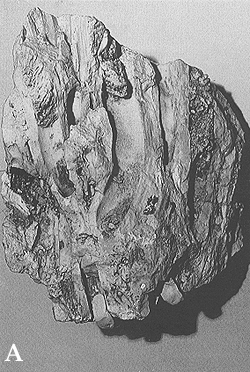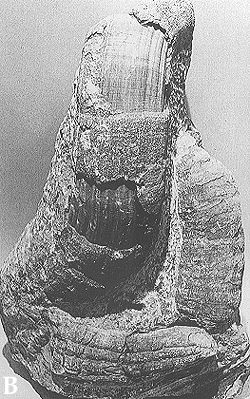

Reef-building organisms in living position
Plate 140


Reef-building organisms in living position
Plate 140
Rudists, seen here in plate 140 A and full relief in B, are extinguished bivalves that had, more or less, the same ecological niche and function of Modern corals. They took root on a muddy or detritus-covered substrate and lived in crowded assemblages or colonies. When the organisms died, new ones grew on them pushing the surface of the colony upwards. Such colonies can be made of animals, algae or both; the organisms secrete calcium carbonate to build their skeletons and to bind each other in a rigid framework capable of resisting the mechanical disturbance of waves and currents. This sort of "pre-lithified" carbonate mass is a reef. A looser aggregation of sedentary organisms, preserved in their living positions but not cemented together, is an organic bank.
Organic reefs and banks grow vertically up to sea level, where further growth is prevented by subaerial exposure and mechanical breakdown; it can go on, however, to compensate for subsidence.
Reef-building animals of different taxa show a similarity of forms due to adaptation to a similar environment (a phenomenon known as convergence, in evolutionary terms). In a reef community, there is a preference for conical shapes, as happens here, and this is a useful way-up indicator (cone apexes point downwards).
A fragment of rudist lies horizontally in picture B; it was probably torn by storm waves.
The samples are conserved in the collection of the Department of Geological Sciences, Bologna University, and come from Cretaceous limestones of Carso (NE Italy) and Murge (SE Italy).
| Photo: G. Piacentini 1970. |